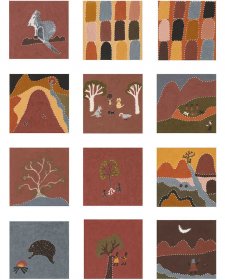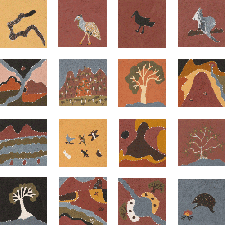Shirley Purdie has lived a storied life, shaped by land, family, law, ceremony and language. She pays homage to the women in her family, representing herself through their collective knowledge, culture and values.

“This tree has the story like the Leichhardt tree but it’s different because it’s when the full moon is really bright, they say that the moon has been climbing up this Thilin-Thilin (bright white gum tree). This tree is also a girl, it has Nyajari (turkey) skin, and it is my Ganggai (grand-daughter). You can see big mob of this tree up on the hills in Violet Valley.”
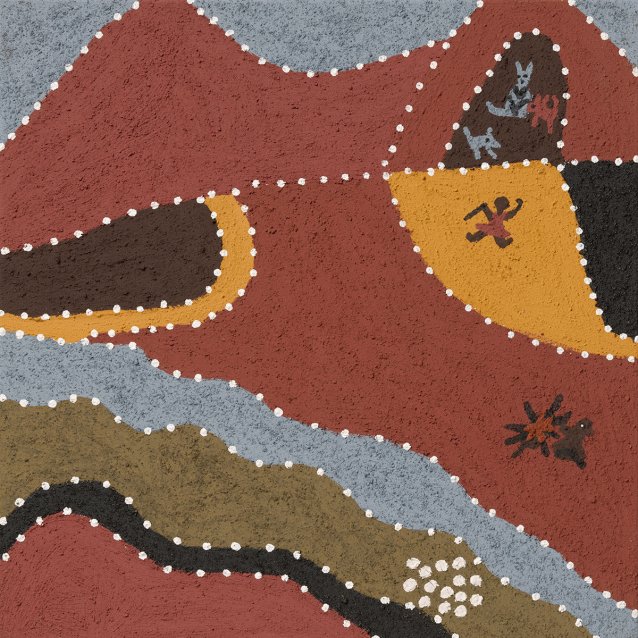
“Me and my grandmother bin looking for nanny goat. We bin find him, and… Well, I bin run up and our dogs, they bin chasing that kangaroo and they bin kill him in this cave. My grandmother bin making fire and me and my grandmother we bin cook him that kangaroo now.”
This memory takes place in Mabel Downs country, near the Yallanji River, during Shirley’s station-work life. The cave still exists today. Shirley recalls being a young girl and going out to hunt goats with her grandmother. In an unexpected turn of events, their dogs chased and killed a kangaroo in the cave. This was a welcome feast for Shirley and her Ganggal (grandmother).

“All the women (the dark circles), when they used to smash the skin for this tree, and poison the fish in the water. They make them fish lose oxygen and come up la water. When that fish bin come out of the water, it’s not poison, they can still eat ‘em.
This the water (grey area). This the two flat rock (yellow and white).”
When Shirley was a little girl, she watched all the old people on Mabel Downs Station. She would go with the old people on weekend outings such as picnics. She’d follow the women to crush the bark of the Mangoonji tree to form a soapy lather. This lather was used as a natural poison to kill the fish, but it was harmless for human consumption. This technique of fishing has been used by Aboriginal people in the Kimberley for many years, and was passed down to Shirley from her ancestors. It was used because people didn’t have fishing lines or nets, and this knowledge from the women helped Shirley’s people survive.

“This echidna is my Dreaming and this is my fire dreaming. When they bin dreaming, they were dreaming for me, and I came out. Same thing with this (fire).”
This is the story about Shirley’s totem – her symbols from her father’s dreaming. Before Shirley was born, her father had a dream that he looked into the fire and received the image of an echidna, which would represent Shirley’s Dreaming.

“This is me. I was cutting that sugarbag (bush honey) and my niece (my brother’s daughter) came with a billycan to get that sugarbag. And when she ate it, she was vomiting. And that was that little daughter for her. That was the sugarbag. That made her sick.”
Shirley is recounting the conception of her niece’s daughter, Melissa (Milly) Martin. Almost 20 years ago, Shirley took Milly, who was then a young woman, hunting for sugarbag from a bloodwood tree near the Violet Valley turnoff. Milly and Shirley ate the tasty sugarbag. Later on, when they came home to Warmun, Milly began to feel nauseous and couldn’t stop vomiting. It was then that they knew she was carrying her child. To this day, Milly can no longer stand the taste of sugarbag. That bloodwood tree is still there at the turnoff.

“This old lady, when she burn that fire stick, and shows it to this new moon, to give us all the fat for everything. Like fish, yam, potato, sugarbag, turkey, fish and kangaroo.”
Mooloonggoogallem is a Gija tradition, where people wish upon a new moon to get big, fat, juicy bush tucker. This tradition was passed onto Shirley from her mother, but it is an age-old Gija tradition, which people still practise today. When a new or crescent moon appears, Shirley teaches her young family, such as her grandchildren and great-grandchildren, to light sticks and to ‘goorrara’ or ‘wish him (the moon)’ for all the fat juicy things they’d like to eat.
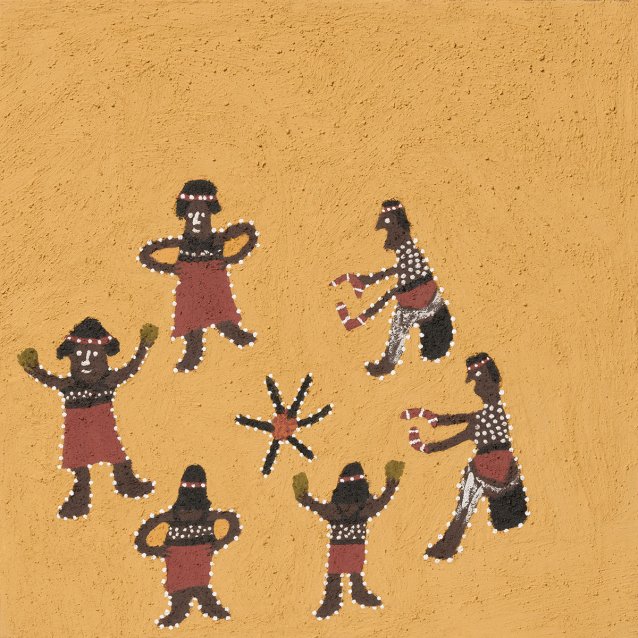
“This corroboree is for women. That’s why its called Moonga Moonga. The painting is before I bin born, but mum’s mob and my aunty (dad’s sister) and all my family used to dance in Gilbun (Mabel Downs). You can see the men are singing with clapping sticks, while the women are dancing. Some old people made up this corroboree, this was when we used to dance for good feeling and happy times.”

“This story for when my mum, aunty and my grandmother, and a school teacher – that gardiya (white) woman, they bin take (her) up there. And they reckon when she been laying down under one of the tree, she bin get all them kangaroo ticks – he a big one, that kangaroo tick, he make you sore and you gotta pull him out. All this lot (my family) picked them out of her. She was red after that.”
Gelbayn Hill is a large hill in present day Mabel Downs. Shirley’s family would often spend leisure time there, and on this occasion, her mother, aunt, and grand-aunt (also referred to as a grandmother) took a school teacher for a visit. The hill is special to Gija people because it is a special burial site; in the past, when the Gija people who lived there died, their remains were wrapped in paperbark and placed in a nearby cave.
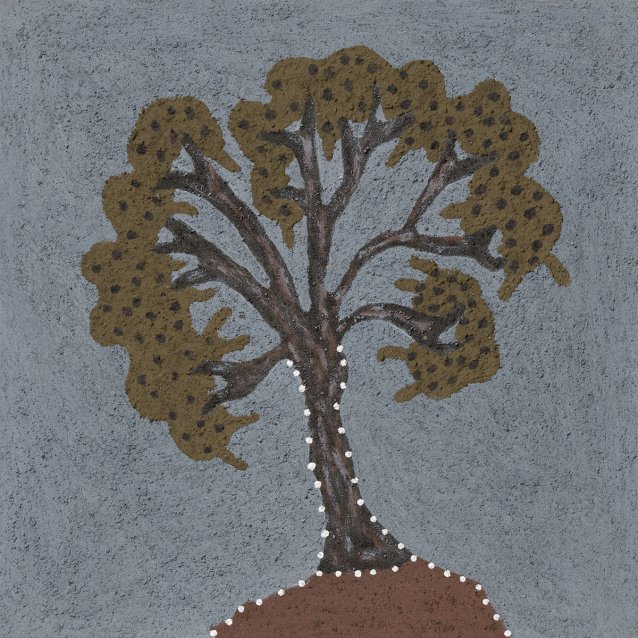
“This is another girl tree. But he got a good tucker, them seeds. This is a nutwood tree, we call him Barregll. They (old people) reckon that when you eat a big mob of the nuts, you get grey hair quicker, because when you look at this tree, the branches are grey.”
The nutwood tree found in Gija country has a tasty nut. The elders passed onto Shirley another story about how the tree can turn people’s hair grey if they eat too many of its nuts. The tree is another feminine-classified tree for Gija people.
All images © Shirley Purdie/Copyright Agency, 2020

